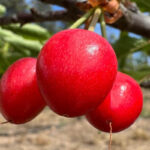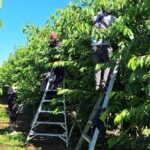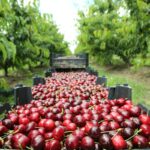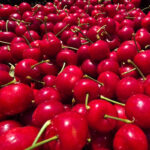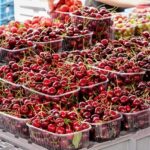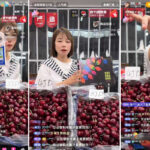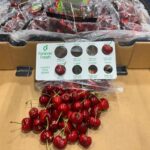Chile: Challenges for cherry exports in the wake of a historic season

The Chilean cherry industry continues to set milestones, positioning itself as the main supplier to the Chinese market, season after season, with volumes on the rise.
For the 2024-25 season, the industry is projecting another record year, with early estimates suggesting around 112 million boxes exported, showing significant potential. However, there are several challenges for the industry ahead of a new season.
To discuss these issues and clarify what lies ahead, IFPA organized a breakfast with industry members in Santiago, Chile.
One of the presenters, Francisco Labarca, partner and executive director of South Port Shipping, indicated that the projections for this year appear to be “quite certain because there have been the cold hours that there were not last season, so it could even be more than 112 million boxes”.
Although there is no official estimate yet from the Chilean Cherry Committee, South Port Shipping has made projections to prepare for the season, based on experiences from previous periods.
“Based on estimates, there will be big differences this season compared to last season during the first weeks,” Labarca said. “This is good news for shippers because it means that between week 46 and 3, there will be about 10,000 more containers of cherries, but they are very well distributed over time.”
In this regard, he commented that during the peak of the season, they estimate to reach 5,600 containers per week, which, despite being a very high figure, is not far from the 5,400 containers per week at the highest point of the previous season.
“I don't see this generating extraordinary stress on shipping capacity, as the peaks are quite manageable,” Labarca said. “This is good news because it means that shipping lines, with the same tonnage (vessel capacity), are going to be able to move much more cargo,” he added.
Challenges to consider
Despite the positive projection in terms of volume, and what this consequently means for the shipping lines in terms of income, Labarca assures that we have to be cautious in terms of transport capacity and phytosanitary management, to keep the fruit moving.
“We are with an impressive transport demand, but the shipping lines have assured us that they have a weekly capacity of 6,500 containers to take cherry to China,” Labarca said.
Although the shipping supply exists, and gives the industry peace of mind, Labarca said that fear exists due to the fruit that must be transported with cold treatment.
He explained that initially, it was estimated that 30% of the fruit transported would require a cold treatment, however, they estimate it to be around 50%. This is due to the fact that the main production areas, including processing plants, are under quarantine for fruit flies.
“If you look at the installed capacity of the plants in affected areas will force healthy fruit to be processed there, and once the fruit enters these plants require cold treatment,” said Labarca.
Under this scenario, he explained that preparing a container with cold treatment, between loading, placing sensors, and making the review takes about an hour and a half.
“At the peak, 705 containers would have to be inspected daily, which means 8 hours per day and requires 88 refrigerators working. The problem is that the suppliers offering this service have an average of 15 reefer operators, so the sum is not enough to check that number of containers per day,” explained Labarca.
The expert raised this issue as one that generates concern but said that there is still time to solve it.
Another logistical issue
Labarca told attendees that packing plants must have their own reefer companies since both exporters and shipping companies are hiring the services of reefer companies, but supply is limited. Through this, he called for working together, indicating that “if we look at this individually, it will be impossible to get that number of service providers”.
He added that the time it takes inspectors to move from plant to plant to start the certification process is very inefficient, a process that could be expedited if each plant hires a permanent and permanent reefer.
Additionally, having many containers with cold treatment sailing, which he estimates can be up to 3,000 at any given time of the season, faults have to be detected before shipping the container.
“There is another issue, which is the responsibility of the shipping lines to upload the information of the cold-treated container at the destination to China's online customs system,” Labarca said.
“The shipping company has to be clear about how the release of the cargo is done, because with these volumes, if any shipping company is slowed down in the process, it can be a commercial disaster because we are not going to be able to move the fruit.”
Labarca called for coordination between shipping lines, service providers, and exporters to agree on an operating protocol that benefits everyone.
Sanitary challenges
Producers and exporters are facing another challenge this season: fruit fly outbreaks in producing areas.
The situation was explained by Rodrigo Barra, head of the Phytosanitary Regulation and Certification Department of the Agriculture and Livestock Service (SAG), who indicated that the area that most worries cherry producers is Chimbarongo since it covers many hectares of producing areas.
“At the moment we have six rehabilitation campaigns; one in Ovalle, two in Valparaíso, two in the Metropolitan, and one in O'Higgins,” Barra said.
SAG is already applying control measures to cancel the quarantine in the affected areas.
The magnitude of the quarantine is due to the measures required by China, which demand a radius of 27.2 kilometers from the location of the outbreaks. The range, Barra explained is quite high, therefore, they are working with the authorities of the Asian country to be able to reduce them.
“Most of the countries with treaties require only 7.2 kilometers for quarantine, including the United States and Japan, however, progress has already been made with China, since previously they required quarantine for the entire region where the fly was detected,” said Barra.
The problem for producers and exporters is that all fruit produced or packed in the quarantine zone must be transported under cold treatment, which, as Labarca explained, adds more work, procedures, and risks to exports.
In Ovalle, where 301 hectares are quarantined for China, and 7 cherry packing plants, the campaign is expected to be lifted in November 2024.
The lifting of the campaign depends on the completion of three fly biological cycles without detection.
In San Bernardo, the quarantined area is 2,552 hectares, where 17 packing plants are located. This campaign is expected to be lifted in December 2024.
And the most relevant sector, in Chimbarongo, there are 15,582 hectares of quarantined cherries and 31 packing plants, where it is estimated that the quarantine will be lifted in January 2025.
Related article: CherryTech 2024: Chile's largest technical cherry industry event
















